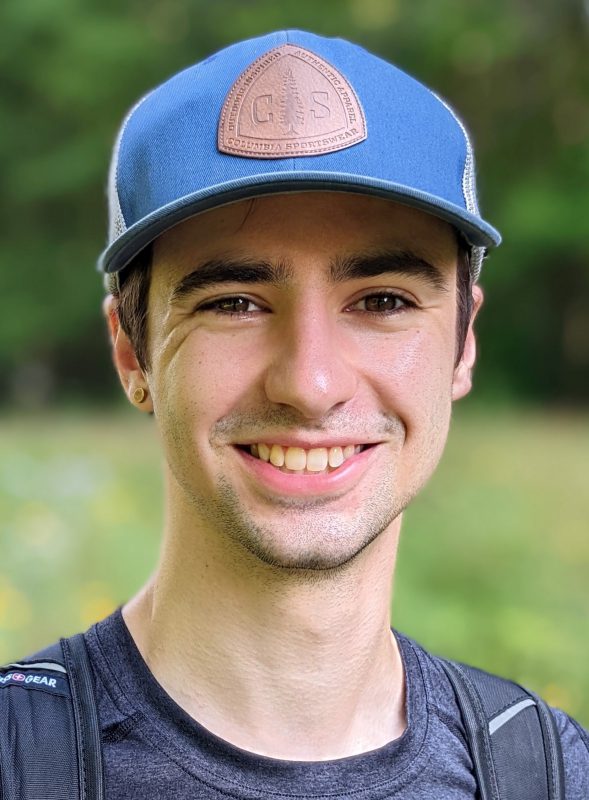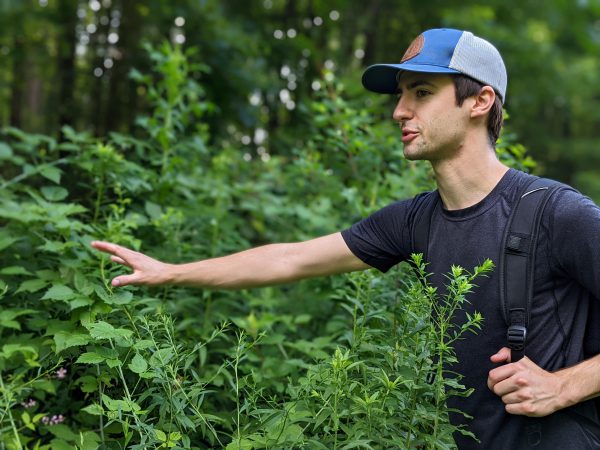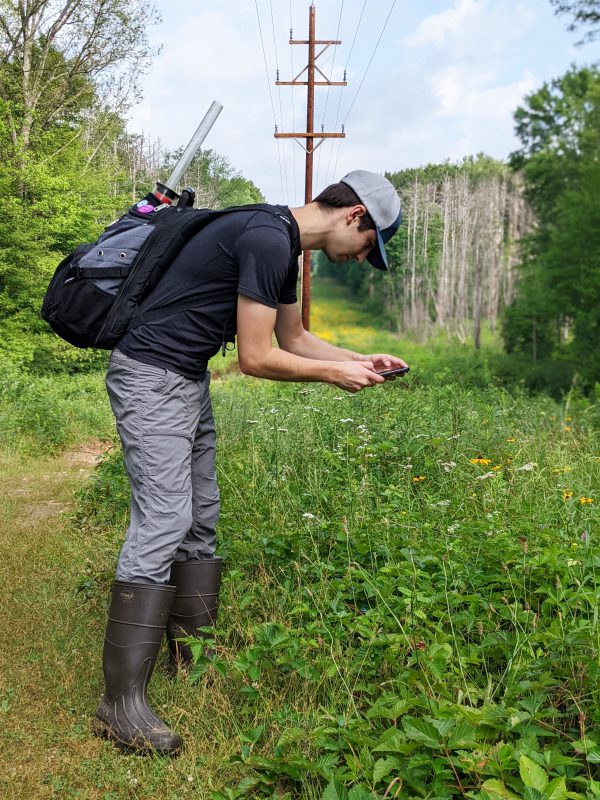


Eli Edlefson ’23 would like to apologize to his elementary school science teachers for doubting them.
“In elementary school, teachers would say, ‘Science always starts with observation,’” Edlefson said. “Then you form a question. I was like, ‘I don’t really know how true that is. You’re just walking around and notice something?’ Then I got out here, and that is absolutely all I’m doing is walking around and noticing, ‘Oh, that’s weird.’ ‘Why is that there?’ ‘This plant has only interacted with this insect species; I wonder why.’ So I would like to apologize to all my teachers.”
“Here” is the Lillian Anderson Arboretum, and while it’s not entirely accurate to say that all Edlefson does there is walk around and notice things, it is a crucial piece of his Kalamazoo College summer fellowship and Senior Integrated Project.
Edlefson is continuing a native wildflower rehabilitation project begun by Professor of Biology Ann Fraser in 2019, which aimed to promote insect pollinator populations by planting a diverse mix of native plants. In 2019, Amy Cazier ’20 completed her SIP by conducting a plant survey and observing and recording plant and pollinator interactions.
Wildflowers Project One of Several Fellowships
Several Kalamazoo College students are completing summer 2022 Environmental Stewardship fellowships through the Larry J. Bell ’80 Center for Environmental Stewardship and we are featuring some of their projects at kzoo.edu. Read on to learn about one of the environmental fellowships making a difference in the local community.



Now, Edlefson is following in Cazier’s footsteps, while occasionally forging his own path, as he surveys the plants and pollinators to assess how successful the biodiversity efforts have been. By summer’s end, he intends to have a comprehensive survey of which plants are growing along the Powerline Trail, where they grow, and which pollinators interact with which plants, along with a comprehensive recommendation for what work is needed to improve the biodiversity of the area.
“I’m comparing what Amy saw to what I see,” Edlefson said. “What’s taking hold? What did we put in the seed mix that I haven’t seen anywhere? Or, is this still a problem plant, like the invasive spotted knapweed?”
Edlefson has also made it his goal to collect a sample of every plant specimen he finds and create a wildflower guidebook.
“I’d like to have some details on the family and species, and some fun facts about it so you can actually connect to the life around you,” Edlefson said. “It’s so easy to walk by, like, ‘Oh, a flower,’ and keep going. I was guilty of that before. Now I know that this is a Deptford Pink, and if I tried really hard, I might be able to pull up a Latin name. When you know more, you appreciate being outside more.”
Learning an interesting fact about a plant makes learning botany more engaging for Edlefson. For example, Native Americans made tea using a small, hanging orange flower called spotted touch-me-not or common jewelweed, which they used as a cure for laziness.
A biology and physics double major who takes pride in having enjoyed “a charcuterie board” of classes in 11 different departments at K, Edlefson originally sought a research experience involving coastal or marine biology for his SIP. After meeting with Fraser, his class’s SIP coordinator, she connected him with the native wildflower rehabilitation project.
While Edlefson has loved bugs his whole life, he had no formal entomology training and very little botany knowledge when he began the project.
“In high school, I was in Science Olympiad, and every time the entomology event was open, I would hop on that,” Edlefson said. “It’s been nice getting a more formal identification process, having Dr. Fraser, who’s like our resident entomologist, and having it be my job to go and collect bugs. I’ve learned a lot already. I never knew how to distinguish wasps and bees besides just eyeballing it; now I know the bees have hairs that are feathered so they collect more pollen, so when you look at them under the microscope, it’s very obvious which one is which.”
Similarly, when he began the project, “I would never have been excited about a plant,” Edlefson said. “If you had said, ‘What’s that flower?’ I would have been like, ‘Yellow.’”
Edlefson has learned a lot about the plants along the Powerline Trail with the help of Fraser and local botanist Russ Schipper. About every other day, Edlefson drives out to the Arboretum on West Main Street and spends the morning surveying his area, which is about 750 meters long and encompasses all the meadow space on either side of the powerline. Initially, his surveys covered little ground, as he had to look up every plant.
“My first day, Dr. Fraser was out here trying to teach me how to use my handy dandy wildflower guide,” Edlefson said. “Of course, she knew everything that was out here, and she was just patiently waiting for me to flip through all the pages and try to figure out what I was doing.”
Now, he can cover his whole territory in a morning. Some days, Edlefson takes notes on what plants are blooming where and collects specimens to press. Other days, he conducts pollinator surveys, either walking 15-minute transects, recording what he sees and occasionally using a vacuum tube to collect specimens, or with a focal survey, sitting in one place and observing a specific plant for 15 minutes to watch for pollinators interacting with the plant.
Sometimes Edlefson uses a camera from the lab to take clear photos of plants for identification. He also uses the iNaturalist app, and the related Seek app, to identify species, learn more and contribute useful data.
Before the project ends, he hopes to conduct night surveys to see if the pollinator landscape is different at dusk.
In the afternoons, Edlefson processes and examines his specimens and organizes his data in the lab.
“The end goal is my candid suggestion about what looks good and what could be improved,” Edlefson said. “The goal of my project is to see if we’re bringing more pollinators in and supporting more of them; I’m looking for better quality and quantity.”
Throughout the course of the summer, Edlefson has learned that he also has a series of deadlines to contend with as various flowers bloom and die.
“If I want to look at a plant, I need to do that before the flowers go away,” Edlefson said. “Sometimes I realize a flower might not still be there next week, so I need to get out there and get a sample before then. It’s not something that I was expecting, to get an idea of what the bloom periods are, when plants are coming and going, and what I should be expecting to see. I’m learning more than I thought I would.
“I’m very much enjoying my time out here. It is a million times better than sitting in an office or just the lab all day. I’m very lucky. It’s a great job.”
To learn more about the project’s history and how you can help, visit the Pollinator Habitat Enhancement Project.
